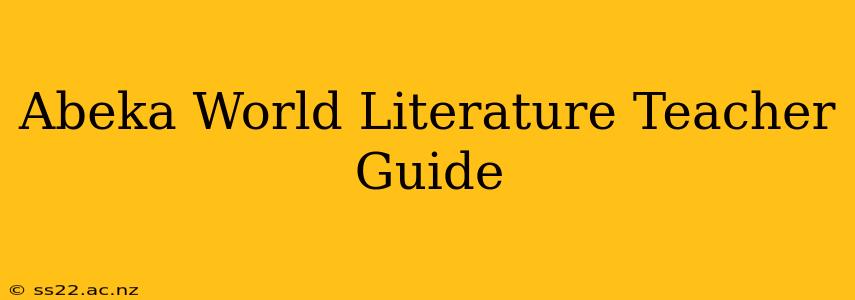The Abeka World Literature Teacher Guide is a cornerstone of the Abeka Academy curriculum, offering a structured approach to teaching literature to high school students. This review delves into its strengths, weaknesses, and overall effectiveness as a teaching resource.
A Structured Approach to Literary Analysis
One of the most striking features of the Abeka World Literature Teacher Guide is its highly structured format. Each lesson provides a detailed outline, including learning objectives, suggested teaching methods, and assessment strategies. This structured approach is particularly beneficial for teachers new to the curriculum or those who prefer a clear, organized framework for their lessons. The guide meticulously breaks down complex literary works into manageable segments, making the material more accessible for students of varying abilities.
Detailed Lesson Plans and Assessments
The lesson plans themselves are comprehensive, offering insightful background information on the authors and their works, along with specific questions and activities designed to foster critical thinking and analysis. The guide provides a variety of assessment tools, including quizzes, tests, and essay prompts, allowing teachers to effectively gauge student understanding. This multifaceted approach to assessment ensures a thorough understanding of the material.
Strengths and Weaknesses
Strengths:
- Comprehensive Coverage: The guide covers a wide range of literary works, representing diverse genres, time periods, and cultural perspectives.
- Structured Approach: Its highly organized format provides a clear roadmap for teachers, ensuring consistency and effectiveness.
- Thorough Assessments: The variety of assessment tools facilitates accurate evaluation of student comprehension.
- Clear Objectives: Each lesson clearly states its learning objectives, ensuring focus and clarity.
Weaknesses:
- Limited Flexibility: The highly structured nature of the guide may limit teachers' ability to adapt lessons to suit individual student needs or preferences. The rigidity might stifle creativity in lesson planning.
- Potential for Overemphasis on Facts: The focus on detailed analysis might sometimes overshadow the importance of fostering a love of reading and literature for its own sake.
- Lack of Diverse Voices: While the curriculum attempts to cover diverse works, it's important to critically assess the representation of different voices and perspectives within the selected texts.
Conclusion: A Valuable Resource with Limitations
The Abeka World Literature Teacher Guide is a valuable resource for teachers seeking a structured and comprehensive approach to teaching high school literature. Its detailed lesson plans, comprehensive assessments, and clear learning objectives provide a strong foundation for effective instruction. However, teachers should be mindful of its limitations, particularly its potential for inflexibility and overemphasis on factual recall. Careful consideration of these factors, and supplemental resources, will enable educators to maximize the guide's effectiveness while fostering a genuine appreciation for literature in their students. Ultimately, its success hinges on the teacher's ability to adapt and supplement the material to best meet the needs of their students and create a dynamic learning environment.
